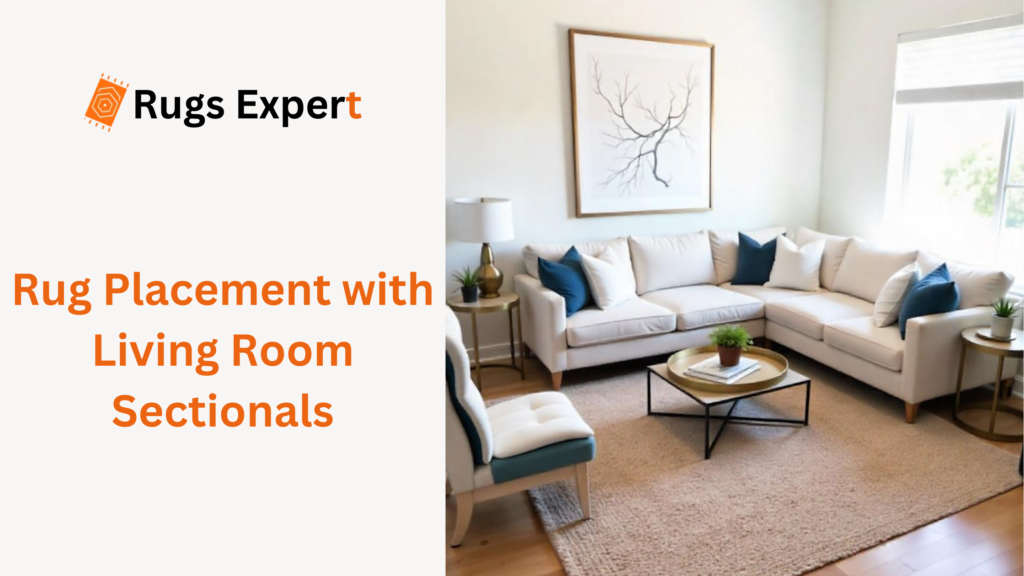
Living rooms with sectional sofas present unique challenges when it comes to rug placement. The right rug can tie your space together, while improper placement can make your carefully designed living area feel awkward and unbalanced.
Also Read: Best overlapping layered cowhide rug living room: A complete guide
In this comprehensive guide, we’ll explore everything you need to know about selecting and positioning rugs with sectional sofas to create a harmonious, stylish living space.
Understanding the Importance of Proper Rug Placement with Sectionals
Sectional sofas have become increasingly popular in modern homes, offering versatile seating arrangements that maximize space and comfort. However, their unique L-shaped or U-shaped configurations require thoughtful consideration when it comes to rug placement.
The right rug not only adds warmth and texture to your living room but also helps define the seating area, absorb sound, and protect your flooring. According to interior design experts at Architectural Digest, a properly placed rug can visually anchor your sectional and create a cohesive look that enhances your entire living space.
Why Rug Placement Matters for Sectional Sofas
When it comes to sectional living rooms, rug placement is particularly critical because:
- Sectionals typically occupy more floor space than traditional sofas
- The unusual shape of sectionals requires careful consideration of rug dimensions
- Proper alignment helps establish visual balance in the room
- The right placement creates defined conversation areas
- A well-positioned rug can make your living room appear larger or cozier, depending on your goals
Standard Rug Sizes for Living Room Sectionals
Before diving into placement strategies, it’s essential to understand the common rug dimensions available and which work best with sectional configurations.
Recommended Rug Dimensions for Different Sectional Sizes
| Sectional Size | Recommended Rug Size | Best For |
| Small L-Shape (under 10′) | 8′ x 10′ | Apartments, small living rooms |
| Medium L-Shape (10-14′) | 9′ x 12′ | Standard living rooms |
| Large L-Shape or U-Shape (14 ‘ +) | 10′ x 14′ or 12′ x 15′ | Open concept spaces, large living rooms |
| Chaise Sectional | 8′ x 10′ or 9′ x 12′ | Depends on the total footprint |
According to Emily Henderson Design, selecting the right size is crucial: “A too-small rug with a sectional is one of the most common design mistakes we see in living rooms. When in doubt, go larger—it’s almost impossible for a rug to be too big.”
How to Measure for Your Sectional’s Ideal Rug Size
When measuring for the perfect rug size for your living room sectional:
- Measure your sectional’s full dimensions, including chaises
- Add at least 18-24 inches on all exposed sides to allow for proper extension
- Consider the other furniture pieces that should sit on the rug
- Account for traffic flow patterns around your section
The chart below illustrates recommended rug sizes based on your room dimensions:
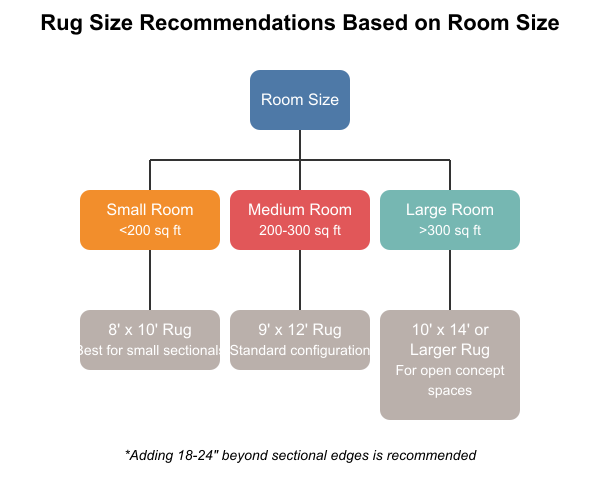
Popular Rug Placement Options for Sectional Sofas
There are several effective approaches to positioning a rug with your sectional, each creating a distinct look and feel in your living space.
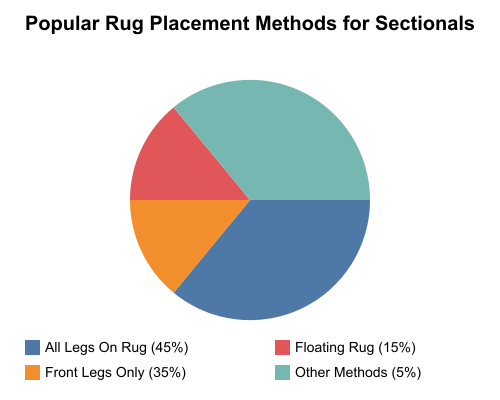
As the chart above shows, the “All Legs On” approach is the most popular among interior designers and homeowners, but each method has its specific advantages depending on your space and preferences.
The All-Legs-On Approach
This classic method involves placing your sectional completely on the rug, with all legs resting on the rug surface. This creates a cohesive, well-defined seating area that feels luxurious and intentional.
Best for: Large living rooms where you have ample space for both a generously-sized sectional and a large area rug.
Pros:
- Creates a unified, polished appearance
- Clearly defines the conversation area
- Provides maximum comfort underfoot
- Protects the flooring throughout the entire seating area
Cons:
- Requires the largest (and typically most expensive) rug option
- May overwhelm smaller spaces
The Front-Legs-Only Position
With this popular approach, only the front legs of your sectional rest on the rug, while the back legs remain on your flooring. This technique works well when you’re trying to balance budget with style.
Best for: Mid-sized living rooms or when working with standard rectangular rugs.
Pros:
- Creates visual cohesion while using a smaller rug
- More budget-friendly than an all-legs-on approach
- Works well for defining conversation areas
- Allows flexibility in sectional positioning
Cons:
- Less cohesive than having all legs on the rug
- May create a visual disconnection with certain sectional shapes
The Floating Rug Arrangement
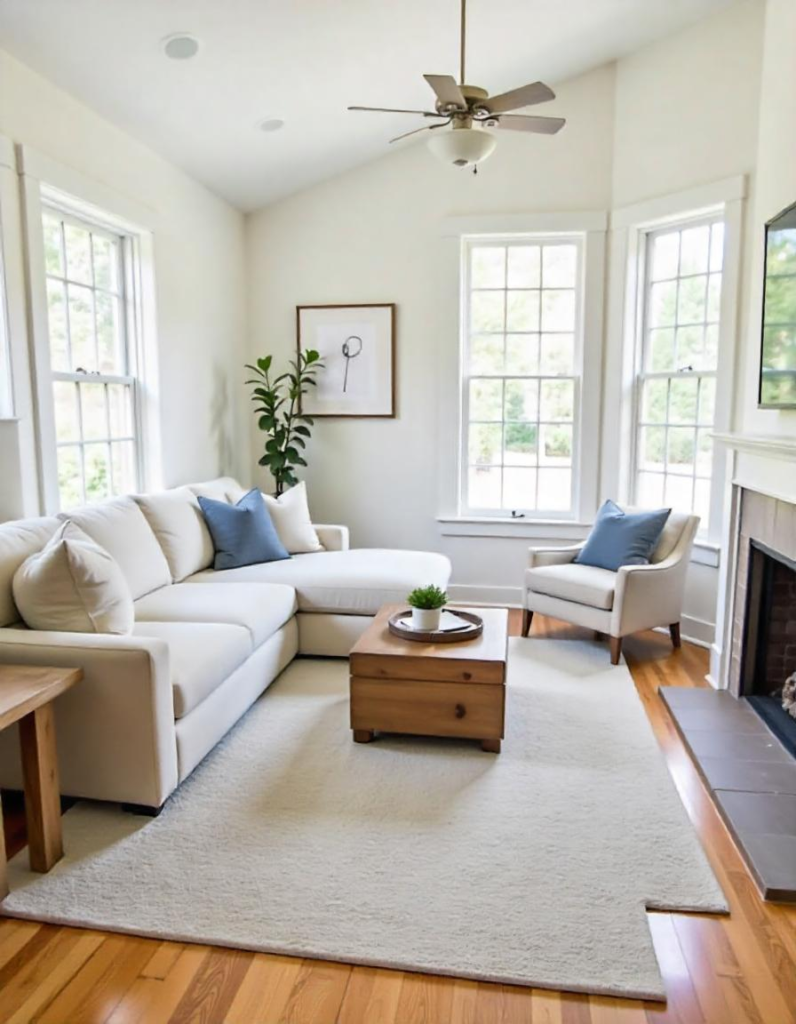
This modern approach places the rug entirely within the boundaries of your sectional, with no sofa legs on the rug at all. The rug essentially “floats” in the center of your seating arrangement.
Best for: Small spaces or when using a distinctive accent rug you want to showcase.
Pros:
- Works with smaller, less expensive rugs
- Highlights a statement rug with unique patterns or textures
- Creates a cozy, intimate feeling
- Allows for easy rug changes without moving furniture
Cons:
- Can look undersized if proportions aren’t carefully considered
- Less effective at defining the overall seating area
Consumer satisfaction surveys show that while the All-Legs-On approach receives the highest satisfaction ratings, layered rugs also score remarkably well as they offer both aesthetic appeal and practical benefits:

Matching Rug Shapes to Your Sectional Configuration
The shape of your rug should complement your sectional’s configuration to create visual harmony in your living room.
Rectangular Rugs with L-Shaped Sectionals
Rectangular rugs are the most versatile and common choice for L-shaped sectionals. According to Houzz, rectangular rugs work well because they:
- Provide a stable visual foundation
- Echo the straight lines of most architectural spaces
- Offer the most size options and price points
- Works well with the geometric nature of sectionals
When placing a rectangular rug with an L-shaped sectional, position it parallel to the longest part of your sectional for the most balanced look.
Square Rugs for Balanced U-Shaped Sectionals
If you have a symmetrical U-shaped sectional, consider a square rug to mirror your seating arrangement’s balanced proportions.
Square rugs work especially well because they:
- Emphasize the central conversation area
- Create perfect symmetry with evenly-sized sectionals
- Can make an elegant statement in larger rooms
Round Rugs for Softening Angular Sectionals
A round rug can introduce a welcome softening effect for sectionals with sharp angles or in living rooms with many hard architectural elements.
Round rugs:
- Create an interesting contrast with the straight lines of sectionals
- Establish a distinct conversation zone
- Works particularly well with smaller sectionals
- Add visual interest and unexpected design elements
According to interior designer Bobby Berk, “A round rug can be the perfect unexpected element that breaks up all the straight lines typically found in living rooms with sectionals.”
Proper Rug Placement Techniques for Different Sectional Configurations
Each type of sectional requires specific placement strategies to maximize both functionality and style.
Positioning Rugs with L-Shaped Sectionals
L-shaped sectionals are the most common configuration and offer several effective rug placement options:
Method 1: Center Alignment Position the rug in the center of the L-shape, with both arms of the sectional having front legs on the rug. This creates balance and helps define the conversation area.
Method 2: Long Side Alignment Align the rug primarily with the longest portion of the L-shape, especially in rectangular rooms. This can make the room feel longer and more spacious.
Method 3: Chaise Consideration If your L-shaped sectional includes a chaise, ensure the rug extends fully under the chaise portion for a cohesive look.
Rug Placement for U-Shaped Sectionals
U-shaped sectionals create a natural conversation pit and require specific rug placement techniques:
Method 1: Centered Containment Place a large rectangular or square rug in the center of the U, extending beyond all sides of the seating area. This frames the conversation space perfectly.
Method 2: Front Alignment Position the rug to align with the front edge of all three sides of the U, creating a unified appearance while using a smaller rug.
According to Wayfair’s design experts, “With U-shaped sectionals, the goal is to create a cohesive conversation area where everyone feels connected—your rug placement should reinforce this.”
Rug Strategies for Chaise Sectionals
Sectionals with a single chaise extension present unique challenges:
Method 1: Full Coverage Use a rectangular rug large enough to accommodate both the main sofa and the chaise portion, with at least the front legs of both resting on the rug.
Method 2: Partial Chaise Coverage. If using a smaller rug, prioritize having the main seating area on the rug, with the chaise partially on the rug or completely off it.
Color and Pattern Considerations for Sectional Rugs
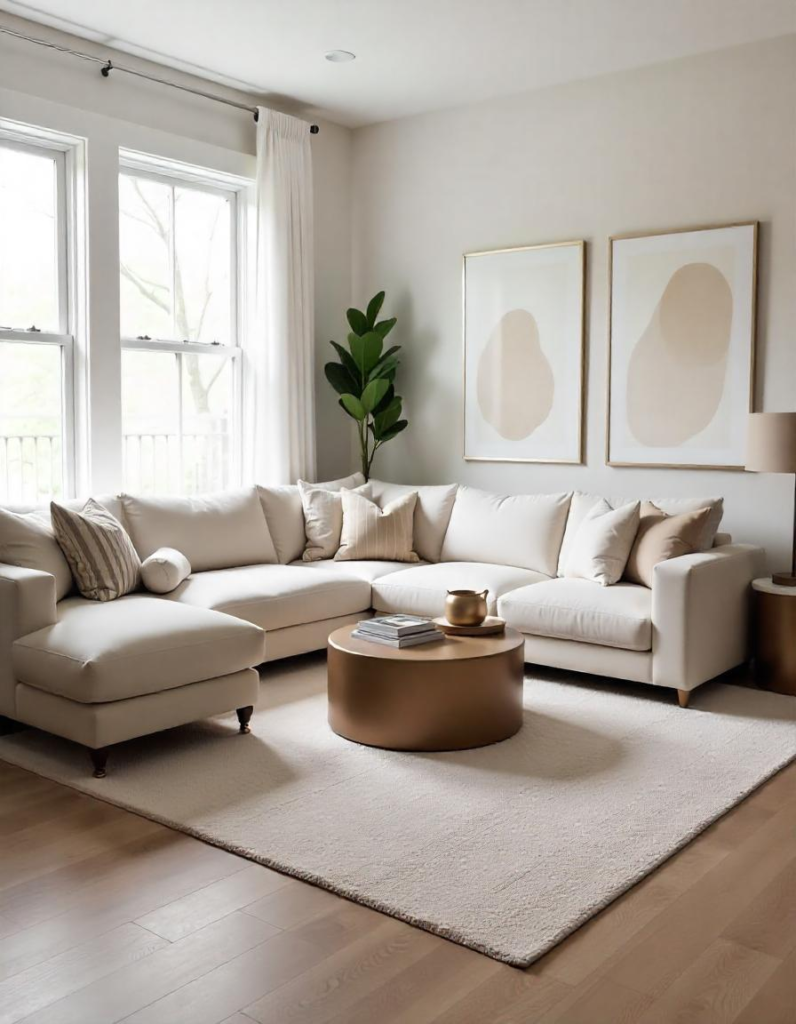
Choosing the right color and pattern for your rug is just as important as proper placement when creating a cohesive living room design with your sectional.
Coordinating Rug Colors with Sectional Upholstery
The relationship between your sectional color and rug color dramatically impacts your living room’s overall aesthetic:
For neutral sectionals (beige, gray, white):
- Bold, colorful rugs can serve as statement pieces
- Patterned rugs with complementary colors add visual interest
- Subtle texture in similar tones creates sophisticated monochromatic looks
For colorful sectionals:
- Neutral rugs in cream, beige, or gray let the sectional shine
- Complementary color rugs create dynamic, energetic spaces
- Analogous color schemes (colors adjacent on the color wheel) create harmony
According to HGTV, “When working with sectionals, which constitute a large visual mass in the room, the rug should either complement the sectional or provide a beautiful contrast—never compete with it.”
Pattern Scale and Sectional Size
The scale of patterns on your rug should be proportionate to your sectional size:
For large sectionals:
- Large-scale patterns hold their own against substantial furniture
- Bold geometrics or oversized florals create balanced visual weight
- Avoid small, busy patterns that can appear fussy against large sectionals
For smaller sectionals:
- Medium to small-scale patterns work well
- Subtle textures and low-contrast patterns create interest without overwhelming
- Consider directional patterns to guide the eye and create movement
Practical Considerations for Living Room Sectional Rug Placement
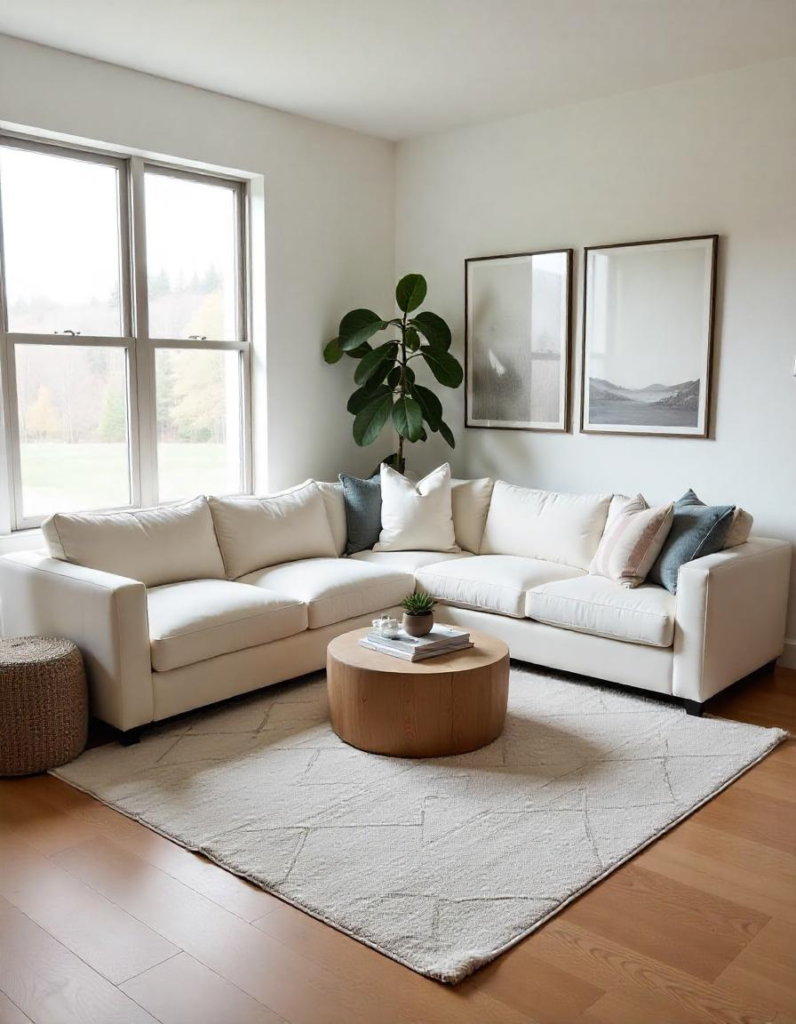
Beyond aesthetics, several practical factors should influence your rug placement decisions for maximum functionality.
Traffic Flow and Rug Placement
Consider how people move through your living room when positioning your rug:
- Extend the rug at least 18″ beyond the sectional in areas where people walk
- Ensure transitions between different flooring types happen in low-traffic areas
- Consider using rug pads with non-slip backing in high-traffic zones
- For open-concept spaces, use the rug to define the living area distinctly from adjacent spaces
Dealing with Awkward Room Layouts
Not all living rooms are perfectly rectangular, which can complicate sectional and rug placement:
For L-shaped rooms: Position the sectional to mirror the room’s shape and use a rug to unify the seating area.
For narrow rooms: Place your sectional against the long wall and use a rug to visually widen the space by extending it toward opposite walls.
For open-concept spaces: Use the rug to clearly define the living room zone within the larger space, creating visual boundaries.
According to Better Homes & Gardens, “In challenging spaces, your rug becomes even more important as a tool for creating logical divisions and flow within the room.”
Seasonal Considerations and Rug Materials
Different seasons may call for different rug materials with your sectional:
Winter comfort:
- High-pile wool rugs add warmth and insulation
- Shag or plush materials create cozy, inviting spaces
- Darker colors help rooms feel warmer and more intimate
Summer freshness:
- Natural fiber rugs like jute, sisal, or seagrass feel cool underfoot
- Low-pile cotton rugs are easier to keep clean when windows are open
- Lighter colors reflect light and create an airy feeling
When selecting the right material for your sectional’s rug, consider both the traffic level in your living room and how much maintenance you’re willing to perform.
Common Mistakes to Avoid with Sectional Rug Placement
Even seasoned decorators can make errors when pairing rugs with sectional sofas. Here are the most common mistakes to avoid.
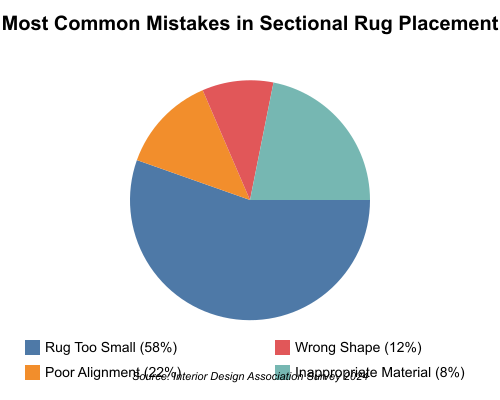
As shown in the chart above, selecting a rug that’s too small is by far the most common mistake homeowners make when placing rugs with sectional sofas.
The Too-Small Rug Syndrome
The most frequent mistake is choosing a rug that’s simply too small for your sectional arrangement:
- A too-small rug makes your entire living room look disproportionate
- It creates a visual disconnection between furniture pieces
- It fails to properly define the conversation area
Solution: Measure your entire seating arrangement and add at least 18-24 inches on all sides. Remember, when in doubt, go bigger.
Improper Rug Alignment
Poor alignment between your sectional and rug can create an unbalanced, haphazard appearance:
- Rugs placed at odd angles to rectangular sectionals create visual tension
- Off-center placement can make the room feel lopsided
- Misalignment with architectural features can make the space feel disjointed
Solution: Align your rug with the room’s architecture and the main lines of your sectional. Use painter’s tape to mark potential placement before committing.
Ignoring the Complete Furniture Arrangement
A common error is focusing solely on the sectional-rug relationship while neglecting other living room furniture:
- Coffee tables should always sit completely on the rug
- Side tables should either be fully on or fully off the rug for consistency
- Adjacent seating (like accent chairs) should follow the same placement rules as the sectional
Solution: Consider your entire furniture arrangement when selecting and placing your rug, creating a cohesive grouping.
Budget-Friendly Tips for Proper Rug Placement with Sectionals
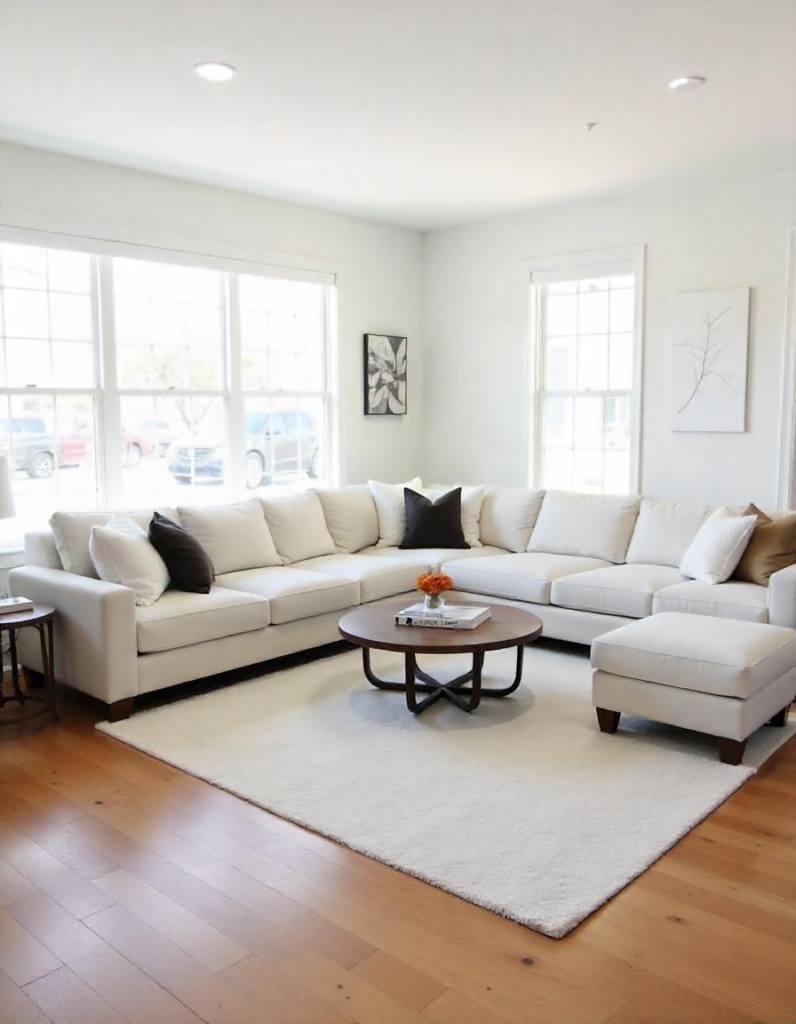
You don’t need to burn your pocket to achieve a beautiful place. Here are some cost-effective strategies:
Layering Smaller Rugs
If a single large area rug exceeds your budget, consider creative layering techniques:
- Use a larger, inexpensive natural fiber rug as a base
- Layer a smaller, more decorative rug on top to define the central conversation area
- Overlap multiple medium-sized rugs to cover the necessary footprint
According to Apartment Therapy, “Layering rugs is not just budget-friendly—it adds depth, texture, and personality to your living space.”
Seasonal Rug Swapping
Maintain different rugs for different seasons to extend their lifespan and refresh your space:
- Heavier, warmer rugs for winter months
- Lighter, easier-to-clean options for summer
- Rotating rugs reduces wear patterns and keeps your decor fresh
DIY Rug Solutions for Unusual Sectional Shapes
For particularly challenging sectional configurations, consider these creative approaches:
- Carpet binding services can custom-cut broadloom carpet to your exact specifications
- Carpet tiles can be arranged to match unusual shapes and configurations
- Multiple coordinating smaller rugs can be strategically placed to accommodate unique layouts
Expert Design Tips for Elevating Your Sectional and Rug Combination
Take your living room design to the next level with these professional insights for combining sectionals and rugs.
Creating Focal Points with Statement Rugs
Use your rug to establish a compelling focal point in your living room:
- Bold patterns draw the eye and make your sectional arrangement more dynamic
- Vibrant colors can energize an otherwise neutral sectional
- Unique materials or textures create tactile interest
Interior designer Kelly Wearstler notes, “A statement rug under a sectional can transform the entire mood of a room—it’s like art for your floor that unifies the entire seating arrangement.”
Balancing Scale and Proportion
Creating visual harmony requires careful attention to scale:
- The size of your rug pattern should complement, not compete with, other patterns in the room
- Consider the ceiling height when determining pile height—lower ceilings pair better with lower-pile rugs
- The visual weight of your sectional should be balanced by appropriate rug texture and color depth
Using Rugs to Define Multiple Areas Within One Room
In larger spaces, strategic rug placement can create distinct functional zones:
- Position one rug under your sectional conversation area
- Use a different rug to define a reading nook or home office space within the same room
- Create a visual connection through complementary (not matching) rug designs
Maintaining Your Rug with a Heavily Used Sectional
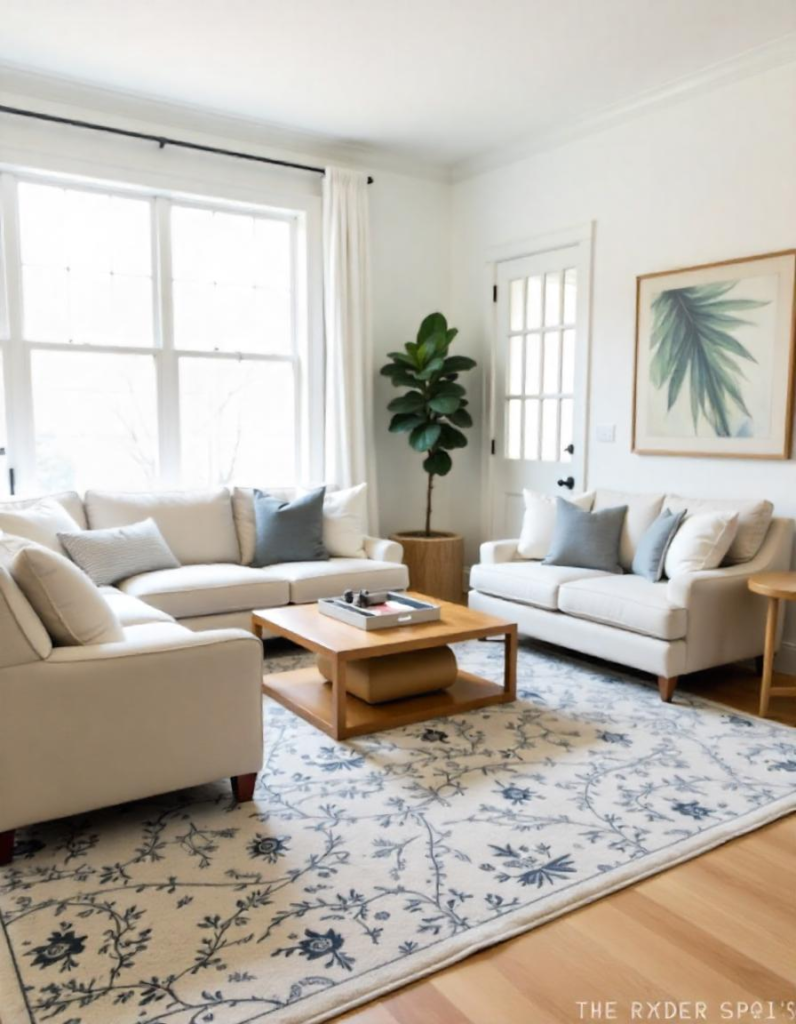
Proper maintenance ensures your rug continues to look great alongside your sectional for years to come.
Protection Strategies for High-Traffic Areas
Sectional seating areas typically see heavy use, requiring special attention:
- Apply fabric protector to both your sectional and rug if appropriate for the materials
- Use furniture coasters under sectional legs to prevent crushing rug fibers
- Consider darker colors or patterns in areas prone to spills or stains
Rotation and Cleaning Schedules
Regular maintenance extends the life of your rug:
- Rotate your rug quarterly to ensure even wear
- Vacuum at least weekly, or more frequently in high-traffic homes
- Schedule professional cleaning annually for wool or delicate materials
- Address spills immediately following the manufacturer’s guidelines
According to carpet care experts at The Spruce, “Regular rotation is especially important with sectional seating arrangements because the wear patterns tend to be highly concentrated in specific areas.”
Conclusion: Creating Your Perfect Sectional and Rug Pairing
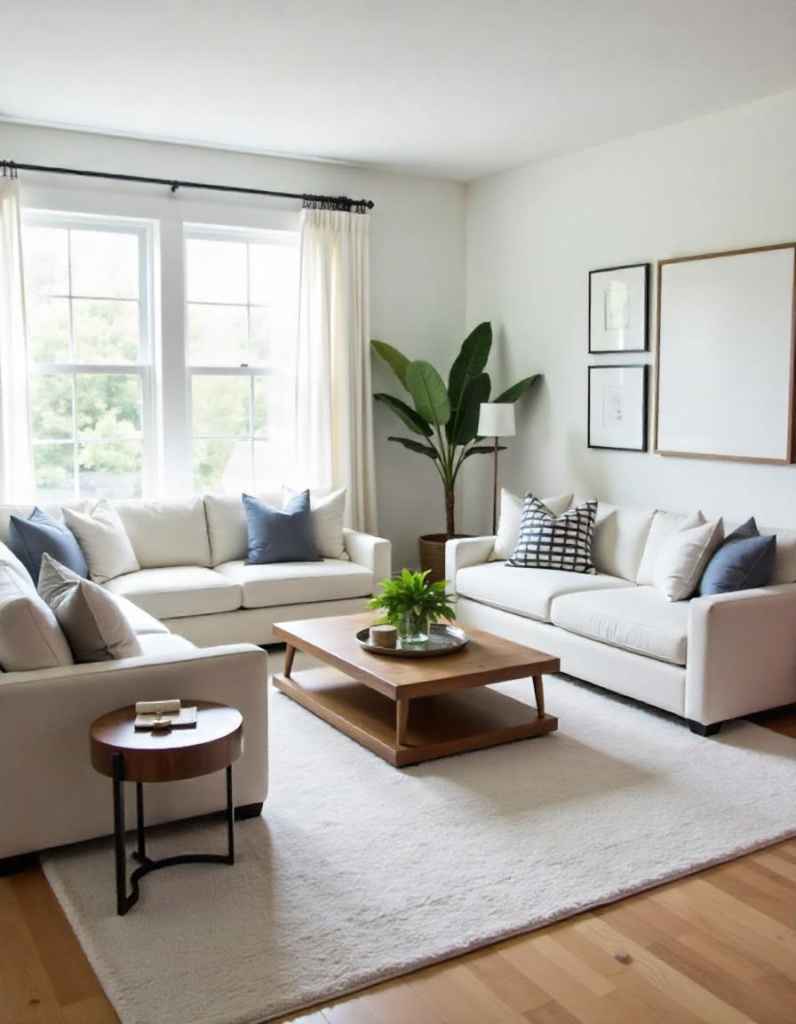
Proper rug placement with your living room sectional creates a foundation for a beautiful, functional space. By considering size, shape, position, color, and practical factors, you can create a cohesive design that enhances your home’s comfort and style.
Remember these key principles:
- Choose a rug large enough to accommodate at least the front legs of your entire sectional
- Align your rug with the architectural lines of your room and furniture
- Consider traffic patterns and functional zones when positioning your rug
- Balance colors and patterns between your sectional and rug
- Maintain your rug regularly to ensure lasting beauty
With these guidelines in mind, you’ll be well-equipped to create a living room that’s both visually stunning and perfectly functional for everyday living.








